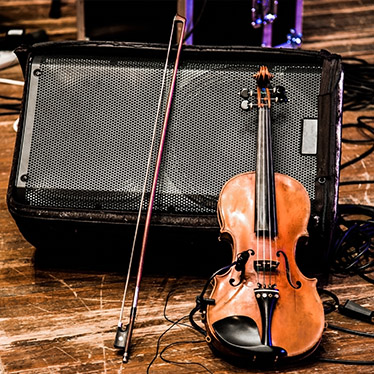What is an Amp For My Violin and How Would I Use It?

Prior to electricity and the advent of instrument amplification, violinists were “instrumental” at parties and dances because violins are one of the loudest, acoustic instruments out there. A single violinist (or a fiddle player or two) was a host needed to get dancers out on the floor – no matter the crowd. Keep in mind that, back then, most crowds at an average social event or gathering with music wouldn’t have topped more than 100 or 200 people.
Today, however, gigs take place outdoors, at large indoor venues, or in crowds that are louder or more boisterous. These events almost always require the assistance of wired amplification to project the violin’s sound more loudly, and across a greater distance.
How do violin amps work?
While some violins are designed to be electric, including a circular, port-style “plugin” connecting the instrument to the amp/soundboard, most violinists straddling the acoustic classical and orchestral worlds, as well as the electric band world, opt to use the same acoustic violin for both playing styles. This requires an acoustic pickup, combined with an electric amplifier.
Pickups are attached somewhere on the surface of the violin’s body, and they connect directly to an amplifier. If you’re playing in a band or group that is amplified, a pickup is your first step, as odds are the group has their own amp(s) you can plug into, or they’ll plug you into their soundboard that connects to the speaker system.
Read, What is a Violin Pickup, to learn everything you need to know about these essential amplification accessories.
Over time and as your public violin gigs pick up momentum, you’ll want to invest in your own amp. In addition to making you more marketable as a solo artist, it can help you out in a pinch if the band your playing with has faulty equipment or their equipment isn’t as high-quality as your violin deserves.
FYI: While there are plenty of great acoustic, violin amps out there, our favorites are those produced by Genzler because they are compact, affordable, and are known for producing clean, nuanced violin tones.
Don’t be afraid to experiment with violin amps
Of course, amplifying your violin is a novel experience, and most beginners feel extremely exposed. Gone is any chance of fingering or bowing snafus blending into the mix. Instead, your playing is front-and-center. A bit of wariness is normal and to be expected, which is why you need to set aside some serious experimentation time.
Talk to your music teacher
See if your music school or school orchestra room is free after hours (or if there are soundproof rooms available) for experimenting. Practicing with an amplifier can be done at home without family around, but there’s always a chance a neighbor may complain. Try to find an off-site location.
Check-in with local colleges and universities
Most colleges and universities have soundproof rooms available for their students to use. Contact the music department and see if they have public options. You may learn that you can “rent” practice space for a small fee.
Look for an amp that has a silent practice mode
Certain acoustic amps by Genzler and other manufacturers have jacks designated to accommodate headphones for silent practice mode. It’s worth investing in that feature if you have a hard time finding public practice space with live amplification. While silent practice mode isn’t exactly the same as genuine, amplified sound – silent practice modes are the best way to hear exactly how you’ll sound when amped, while allowing you to practice virtually anywhere – knowing only your typical playing volume is audible to nearby family, friends, or students.
Don’t be shy. Be bold and take the plunge into amplified violin sound. The ability to amplify your sound broadens your playing horizons, opening the doors across musical genres and into new gig venues.

